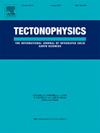东非裂谷系统乌桑古盆地的地下基底结构及其对盆地结构构造和油气潜力的影响
IF 2.7
3区 地球科学
Q2 GEOCHEMISTRY & GEOPHYSICS
引用次数: 0
摘要
乌桑古盆地是一个裂谷盆地,沿东非裂谷系统东臂发育,呈东北-西南走向。虽然对该盆地的总体结构已有深入研究,但对盆地的结构构造以及沉积厚度的空间和深度变化仍不甚了解。本研究利用航天飞机雷达地形图任务(SRTM)数字高程模型(DEM)、航空磁力和重力数据,对盆地内与基底构造相关的结构和沉积厚度变化进行了研究。数字高程模型数据结果表明,盆地两侧有几条代表乌桑古断层和奇马拉边界断层的线状构造,盆地中部没有构造。气磁和重力数据突出显示了三组正断层和走向滑动断层,其中大部分呈东北-西南走向,其他呈东北-西南走向,少数呈西北-东南走向或西北-东南走向。盆地西南部的构造显示出复杂的模式,这归因于研究区域集中了重要的构造和地震活动。用于计算基底深度的欧拉解卷积和重力模型显示,基底在北部和南部至西南部较浅,盆地在东北部、西北部和西部加深。研究结果还显示,盆地内有两个地堑、地槽、洼地和盆地内基底,其走向与盆地构造一致。充填盆地的沉积物一般厚度为 3 至 4.5 千米,在盆地南部和西南部的两个沉积中心,沉积物的最大堆积厚度达 4.8 千米。所获得的沉积物深度范围意味着该盆地具有油气勘探的潜力,有可能出现天然气。本文章由计算机程序翻译,如有差异,请以英文原文为准。
Subsurface basement structures of the Usangu basin, East African rift system, with implications for basin structural configuration and hydrocarbon potential
The Usangu basin is a rift basin developed along the Eastern arm of the East African rift system trending in the NE-SW direction. Although the general structures of the basin have been well studied, the structural configuration of the basin and the spatial and depth variations of sediment thickness are still not well known. This study investigates the structures related basement configuration and the variation of sediment thickness within the basin using the Shuttle Radar Topography Mission (SRTM) Digital Elevation Model (DEM), aeromagnetic and gravity data. Results from DEM data indicate a few lineaments on the basin flanks representing the Usangu and Chimala border faults with no structures in the central part of the basin. The aeromagnetic and gravity data highlight three sets of normal and strike-slip faults, most of which trend NE-SW and others NNE-SSW, while a few trends WNW-ESE or NW-SE. Structures on the southwest of the basin reveal complex patterns attributed to the concentration of important tectonic and seismic activities in the study area. The Euler deconvolution and gravity models used to calculate the depth to the basement show that the basement is shallow in the north and south to southwest, and the basin deepens in the northeastern, northwestern and western parts. The findings also reveal that the basin has two grabens, troughs, depression and intrabasinal basement trending in the same direction as the basin configuration. The general thickness of sediments filling the basin ranges from 3 to 4.5 km, with the maximum accumulation of sediments reaching up to 4.8 km in the two depocenters at the south and southwest of the basin. The depth range of the sediments obtained implies that the basin has potential for hydrocarbon exploration with the possibility of natural gas occurrence.
求助全文
通过发布文献求助,成功后即可免费获取论文全文。
去求助
来源期刊

Tectonophysics
地学-地球化学与地球物理
CiteScore
4.90
自引率
6.90%
发文量
300
审稿时长
6 months
期刊介绍:
The prime focus of Tectonophysics will be high-impact original research and reviews in the fields of kinematics, structure, composition, and dynamics of the solid arth at all scales. Tectonophysics particularly encourages submission of papers based on the integration of a multitude of geophysical, geological, geochemical, geodynamic, and geotectonic methods
 求助内容:
求助内容: 应助结果提醒方式:
应助结果提醒方式:


